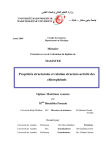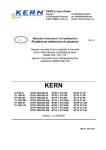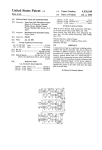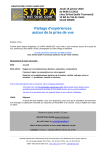Download Universal electrical connection apparatus
Transcript
O Unlted States Patent [19] [11] 4,386,333 Dillan [45] May 31, 1983 [54] UNIVERSAL ELECTRICAL CONNECTION I APPARATUS [75] Inventor: . George 0. Dillan, Boulder County, C°1°- [73] Assignee: 7600749 958885 , 8/ 1976 Netherlands .................... .. 339/32 R 5/1964 United Kingdom ......... .. 323/340x OTHER PUBLICATIONS IBM Technical Disclosure Bulletin, “Copier/Collator International Business Machines - Corporation, Armonk, NY. Apparatus”, A- J- B0116, l H- Hubbard, J- P- Jord?n, H Kelm, R. J. LeClere and S. W. Zieg, 12/76 pp. 2444, 2445. [21] APPL No" 317’108 IBM Technical Disclosure Bulletin, “Connection [22] Filed: Alignment Pin With Selectable Key”, C. R. Pettie, pp. Nov. 2, 1981 [51] Int. c1.3 ............................................ .. H01F 27/04 624’ 625’ 7/72' [52] us. Cl. .................................. .. 336/107; 323/328; 1 0- Penney Sen/Ice Manual’ “Black and Whlte Televl 323/340; 323/341; 336/149; 336/150; 339/13 [513] , _ Sion Model 1038B” (7 99-) Form N9 28129_55—1 P; 339/31 M; 339/32 R; 339 /32 M; 339/33- J. C. Penney Manual “Location and Operation of Cus Field of Search‘ ..................... .. 336/107, 150, 149; tomer Controls and Battery Model 1038B” (4 99-), 339/18 P, 31 M, 32 R, 32 M, 33; 323/328, 340, 341 Form No. 2812953-1. IBM Series III Copier/Duplicator Service Manual, pp. . [56] 162, 163, Form No. 241-5928—0. References and Electronic Design, 11/22/80, p. 296. U.S. PATENT DOCUMENTS _ v 18; , _ , 2,417,928 2,930,019 29121-13111" ' c an .. ... 3/1947 Guernsey . 3/ 1960 Hubbell 173/361 - ..... .. 173/361 ....... .. 339/31 6/1961 Aarlaht ........... .. 3,034,000 5/1962 Todd _ _ _ _ _ ’ . _ ‘ _ ' . _ “ 336/150 X 3,082,302 3/1963 Rumble 2/1964 Hubbell ...... .. 4/1974 Ferdelman 4,053,788 10/1977 _ Assistant Examiner-Susan Steward . . . . . . . . . . . . . .. 2,989,719 3,l20,985 3,802,159 [ Primary Exammer—A. T. Grlmley 339/31 ...... .. zoo/51.03 3.39/31 M ....... .. Robie .................................. .. 307/11 FOREIGN PATENT DOCUMENTS 1056222 4/1959 Fed. Rep. of Germany . 267689 4/ 1966 Fed. Rep. of Germany .... .. 336/150 2243825 8/1972 Fed. Rep. of Germany . 1503482 10/ 1967 France . 1545854 10/1968 France . __ Attorney’ Agent’ or F'rm Gunter A‘ Hauptma“ [57] ABSTRACT . . - . . Different llne-cord sets connect an electrical devlce to different supply voltages, assuring that the Supply volt age matches the device. Each line-cord set has a uniquely keyed socket and a wall A device recep tacle receives the line-cord’s keyed socket. An adjust able key on the device mates with the socket’s key and rejects nonmating sockets to admit the socket into the receptacle and adjusts the device’s input voltage to match the supply voltage. 6 Claims, 9 Drawing Figures US. Patent‘ May31, 1983 Sheet 1 of7 4,386,333 US. Patent May 31, 1983 Sheet 2 of7 4,386,333 US. Patent May 31, 1983 Sheet 3 of? A l I // 4,386,333 US. Patent May 31, 1983 Sheet 4 of 7 4,386,333 a8 5ma NEH r-r ll IU II / llHll 1 x2: US‘. Patent May 31, 1983 Sheet 5 of 7 4,386,333 - Na E2x»03Q<> 9; ?i| _____________________J uwL §§\.uan=1___w m n 30x» m u no; u . _ _ .2“. vé - _ _ "0.1” 3‘2, US. Patent May 31, 1983 Sheet 6 of 7 US. Patent May 31, 1983 Sheet 7 of 7 4,386,333 4,386,333 1 2 The prior art does not teach a single device recepta cle uniquely mated to each one of a multiplicity of line cord sets and to the device’s power supply, wherein inadvertent mismatches cannot occur. UNIVERSAL ELECTRICAL CONNECTION APPARATUS BACKGROUND OF THE INVENTION 5 The invention provides plural plug and socket line cord sets, usable with a device having a variable power 1. Field of the Invention interface, for assuring that the plug’s supply voltage The invention relates to apparatus for connecting an matches the device’s input voltage. Each line-cord set electrical device to a power source and, more particu has two essentially permanently attached end connec 10 tors: a keyed socket and a wall plug. The keyed socket different source voltages. has a unique predetermined con?guration for the one 2. Description of the Prior Art supply voltage to which the wall plug at the other end Electrical devices, such as copiers, computers, audio is designed to connect. A device receptacle connected components, household appliances, etc., frequently op to the device’s power interface receives the line-cord’s erate on only one voltage but must be used with differ keyed socket. An adjustable key on the device mates ent power supply voltages. For example, a 115 VAC 60 with the keyed socket’s con?guration and rejects non Hz copier wired with a 115 VAC 60 Hz style plug may mating line-cord sockets. Adjusting the receptacle’s key have to be used where only a 230 VAC 60 Hz power to mate with the keyed socket plug; (a) admits the line supply outlet is available. Substitution of a 230 VAC 60 larly, universally adapting a single-voltage device to cord socket into the receptacle and (b) varies the de vice’s power interface to match the device’s input volt age to the supply voltage for which the wall plug is ,Hz plug together with appropriate wire reconnections permit 115 VAC copier operation from the 230 VAC outlet. However, serious hazards to an operator and ‘machine safety are created. For example, a plug or designed. socket wiring error introduces 230 VAC to copier parts designed for 110' VAC. The reverse situation creates analogous problems. In addition to the hazards of rewir ing a 230 VAC device for 110 VAC outlets, the lower BRIEF DESCRIPTION OF THE DRAWINGS FIG. 1A illustrates a device incorporating the inven tion. FIGS. 1B—1D show mechanical aspects of the device supply voltage 'will probably not effectively operate most 230 VAC devices. receptacle. ' FIG. 2 shows the invention schematically. Electrical devices incorporate solutions to some of FIG. 3 details the variable voltage converter of FIG. 2. A second voltage converter embodiment appears in FIG. 4. FIGS. 5 and 6 illustrate two line-cord sets usable in these problems. The 115 VAC IBM Series III copier connects directly to 230 VAC power supply voltage through appropriate wiring between its internal compo nents and a 230 VAC plug. A line cord adapter, when placed between the 230 VAC plug and a 115 VAC the invention. power supply socket, provides essential wiring inter DETAILED DESCRIPTION connections, but does not affect the copier’s voltage requirements. Voltage switches advertised in ELEC TRONIC DESIGN, Nov. 22, 1980, page 296, permit different power supply voltage connections, but do not insure that the switch positions match the connected voltages. IBM TECHNICAL DISCLOSURE BUL LETIN, December 1976, pages 2444 and 2445 describe a special circuit for protecting a copier/collator from being inadvertently plugged into the wrong line. Keyed mating plugs and sockets appear in IBM TECHNICAL DISCLOSURE BULLETIN, July 1972, pages 624 and 625, and German Publication No. 2,243,825, Mar. 14, 1974. Alternatively, separate device-mounted sockets for each possible power supply voltage and matching, removable line-cord sets for each power source voltage may be provided with the device. The latter solution requires circuits for removing electrical potential from In FIG. 1A, an electrical device 101, such as a com puter, ampli?er, household appliance, etc., carries an electrical connector 102 for receiving electrical power supply voltage when an appropriate connector is in serted into a receptacle 103. A rotatable disc 104 de?nes insertable connectors, barring other connectors, in ac cordance with the particular supply voltage for which the device 101 is conditioned by the disc 104. Typically, 45 electrical device 101 operates on a supply voltage of 115 VAC. Therefore, physically distinguishable connectors associated with supply voltages of, for example, 105 VAC, 115 VAC, 209 VAC, and 230 VAC, are insert able into the receptacle 103, depending upon the disc 50 104 position. As the disc 104 is rotated, the different connectors become insertable. Simultaneously, the de vice 101 is conditioned for the correspondingly differ ent supply voltages. Actual voltage applied to circuits unused sockets. French Pat. No. 1,545,854 discloses two inside the device 101 therefore remains at, by way of sockets, one covered, alternately selectable, connected 55 example, approximately 115 VAC. to a power supply voltage changing switch. U.S. Pat. The electrical connector 102 of FIG. 1A appears in Nos. 2,930,019 and 2,989,719 disclose plugs and sockets more detail in FIG. 1B. The receptacle 103 includes a adjustable for a plurality of power sources. However, grounding conductor 105, two phase conductors 106 since each must be manually rewired for different volt and a neutral conductor 107 connectable to a mating age sources, a voltage mismatch is possible. Portable 60 socket arranged to receive the conductors 105—107_. The radios provide one receptacle both for 110 VAC opera disc 104 rotates peripheral keys 109-112 and a switch tion and, specially slotted, for 12 VDC automobile op 113 when an operator turns a screwdriver slot 108 or eration. A 12 VDC socket projection switches the otherwise grasps and turns the disc 104. One of keys power source directly into the radio’s DC power sup 109-112 locks into position adjacent the receptacle 103 ply. In French Pat. No. 1,503,482, a notched dial rests 65 to mate with one socket and bar others. For example, in . on a plug inserted into an electric razor. While the dial the position shown in FIG. 1B, a socket designed for a operates a circuit adapting the razor’s voltage, operator 105 VAC power supply mates with key 109. Additional error connects the wrong power supply voltage. power supply values appear on the view of disc 104 in 3 4,386,333 FIG. 1C. FIG. 1D, which is section 1D, through FIG. 1C, shows how disc 104 rotation operates rotary switch 4 FIGS. 5 and 6 illustrate two line-cord set 201 designs usable in the invention. In both FIGS. 5 and 6, keyed socket 202 and a wall plug 203 are connected together 113. A shaft 114 connects disc 104 to switch rotor 117 which completes contacts, in a well known manner, as by a line cord 204. It is important that the socket, cord and plugs 202-204 be integrally formed, as by molding, it steps through positions held by a ball detent 115 and spring 116. to bar tampering. In FIG. 5, the wall plug 203 is in FIG. 2 illustrates an electrical device 101 carrying an tended for insertion into a 115 VAC wall socket, not electrical connector 102. Receptacle 103 receives a mating keyed socket 202 connected to a wall plug 203 shown, requiring a wall plug 203 with three connectors 705-707 arranged as shown. The corresponding keyed socket 202 115 VAC key 510 identi?es the potentials via a line cord 204 of a line-cord set 201. Receptacle 103 also connects to output cable 205 and output socket 206 present at conductors 505-507: 115 VAC between the Y phase conductor 506 and the neutral conductor 507. In the case of the line-cord set 201 in FIG. 6, 230 VAC appear between the Y and X phase conductors 606. through rotary switch 113. An output plug 207 is in serted into output socket 206 to ultimately connect cable 208 and utilization circuit 209 to power supply voltage at wall plug 203. The actual voltage applied to the utilization circuit 209 depends upon the position of disc 104 and the mating keyed socket 202 on line-cord In operation, electrical device 101 is installed by choosing the line-cord set 201 that has a voltage desig set 201. The receptacle 103 and disc 104 in FIG. 3 are ar and a wall plug 203 which ?ts into the wall socket nation matching the power supply voltage available, provided for that power supply voltage. The disc 104 is then rotated to line up the keys 109-112 corresponding to the selected voltage and the keyed socket 202 is inserted into the receptacle 103. The selected position of disc 104 provides a rotary switch 113 position that ranged to receive a mating keyed socket 202 connected to a 115 VAC wall plug 203, as shown in FIG. 5. Rota tion of the disc 104 two steps (in either direction) rear ranges the receptacle to receive instead a socket 202 connected to a 230 VAC wall' plug 203, as shown in maintains the voltage at output socket 206 the same for FIG. 6. The choices of keys 109-112 and the corre "widely different wall socket power supply voltages. If, sponding voltages are arbitrary. In FIG. 3, the rotary for example, the wall plug 203 in FIG. 5 connects to 115 VAC, this voltage appears across conductors 706-707, 506-507 and 106(Y)-107 (FIG. 3). With rotor 117 in the 104 rotates switch shaft 114. Receptacle 103 phase con 30 position shown in FIG. 3, 115 VAC at the Y and neutral ductors 106 supply power supply voltage (in this exam inputs of primary 302 of transformer 301, appears as 115 ple, 115 VAC) from wall plug 203 to transformer 301 VAC at conductors 306-307. If instead, wall plug 203 in switch 113, rotor 117, connects one at a time of switch contacts 309-312 to one wire in output cable 205 as disc connected to rotary switch 113. In the example of FIG. 3, the 115 VAC line-cord set 201 keyed socket 202 FIG. 6 connects to a 230 VAC power supply, this volt age appears in connectors 806, 606 and 106. However,‘ (FIG. 5) could be inserted into the receptacle 103 only rotor 117 now will be at contact 312 and 115 VAC still after the disc 104 was rotated to position switch rotor 117 at the 115 VAC switch contact 310. This switch contact 310 connects to a transformer 301 secondary 303 output Y><l which provides the same voltage as will appear at conductors 306-307. was applied at transformer 301 primary 302 input Y connected to one of the phase conductors 106. If, in stead, the 230 VAC line-cord set 201 (FIG. 6) had been . used, the disc 104 would have positioned the rotor at the 230 VAC contact 312 connected to the same output ‘ ' ' 1. Apparatus for connecting an electrical device to a plurality of supply voltages, including: Y>< 1. As a result, 230 VAC (between phase conductors 106) which is 115 VAC (between Y conductor 106 and a voltage converter, having a control, a voltage out put connected to the device, and a voltage input, the converter being operable by the control to vary conductor 107) appears as 115 VAC on the wire in output cable 205 connected to rotor 117. Similarly, 105 VAC, 115 VAC, 209 VAC or 230 VAC between the phase conductors 106 of receptacle 103 always appears ‘ While the invention has been particularly shown and described with reference to preferred embodiments thereof, it will be understood by those skilled in the art that various changes in form and details may be made therein without departing from the spirit and scope of the invention. What is claimed is: the input to output voltage ratio; 50 a plurality of line-cord sets each having a plug at one as 115 VAC between phase conductor 306 and neutral end mateable with a prede?ned supply voltage and conductor 307 of output socket 206; because, the disc a connector at the other end having a unique shape 104 and therefore the rotor 117 must be appropriately moved to enable the receptacle 103 to receive the corre identifying the plug’s supply voltage; ‘ a voltage receptacle connected to the converter input spondingly keyed socket 202. As shown in FIG. 3, the receptacle 103 neutral con ductor 107 is connected to the transformer 301 primary 302. The Y conductor 106 connects to the other end of primary 302, while the X conductor 106 is not used. The ground conductor 105 may connect via output cable 60 205 to ground connector 305 of output socket 206. for receiving one line-cord connector at a time; and mechanical keys, attached to the converter’s control, each positionable to de?ne a connector receivable by the receptacle and bar other connectors; whereby, operation of the control to permit the re ceptacle to receive a connector varies the input to output voltage to provide substantially the same‘ output voltage for different supply voltages. Other voltage conversion devices may be used in place of transformer 301. For example, the transformer 301 2. The apparatus of claim 1 whereinthe voltage con may be omitted or replaced by a “Y” or “Delta” wound verter is a multitap transformer'connected to a switch ' transformer using both X and Y conductors 106. In 65 moved in accordance with mechanical key positions to FIG. 4, an autotransformer winding 401 connects to select different taps and, therefore, output voltages. transformer 301 input wires 304 and output wires 308 in 3. Apparatus for connecting an electrical device to a place of the device in FIG. 3. plurality of supply voltages, including: 5 4,386,333 a voltage converter, having a control, a voltage out put connected to the device, and a voltage input, the converter being operable by the control to vary the input to output voltage ratio; a plurality of line-cord sets each having a plug at one end mateable with a prede?ned supply voltage and a connector at the other end having a unique shape identifying the plug’s supply voltage; end with pins mateable with a prede?ned voltage a voltage receptacle connected to the converter input supply and a connector at the other end having a for receiving one line-cord connector at a time; and 10 mechanical keys, formed on the circumference of a disc attached to the converter’s control, the disc being rotatable to bring one key at a time into a position to de?ne a connector receivable by the receptacle and bar other connectors; whereby, rotation of the disc operates the control to permit the receptacle to receive a connector, and stantially the same output voltage for different supply voltages. unique shape identifying the plug; a voltage receptacle connected to the switch input for receiving one line-cord connector at a time; and indentations, formed on the circumference of a disc attached to the switch’s manual control, the disc being rotatable to bring one indentation at a time into a position to mate with a connector shape receivable by the receptacle and to bar other con nector shapes; whereby, rotation of the disc permits the receptacle varies the input to output voltage to provide sub 20 to receive one mating connector, and varies the input to output voltage to provide substantially one 4. The apparatus of claim 3 wherein the voltage con output voltage for different voltage supplies. verter is a multitap transformer connected to a switch 6. The apparatus of claim 5 wherein the voltage moved in accordance with disc rotation to select differ ent taps and, therefore, output voltages. 6 5. Apparatus for connecting an electrical device to any one of a plurality of supply voltages, including: a voltage switch, having a manual control, a voltage output connected to the device, and a voltage in put, the switch being operable by the manual con trol to vary the input to output voltage ratio; a plurality of line-cord sets each having a plug at one switch includes a transformer. 25 30 35 45 50 55 65 *****


























